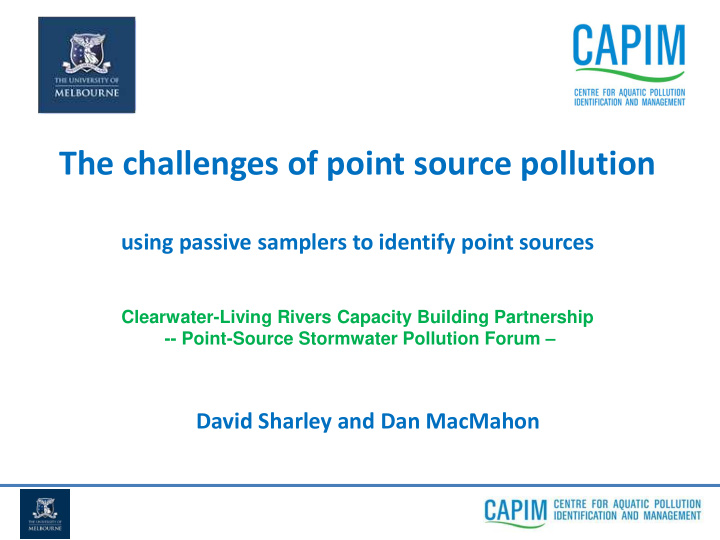



The challenges of point source pollution using passive samplers to identify point sources Clearwater-Living Rivers Capacity Building Partnership -- Point-Source Stormwater Pollution Forum – David Sharley and Dan MacMahon
Point source pollution • Single identifiable source of pollution • Often the result of accidental discharge or deliberate disposal • Isolated or consistent - consistent pollution events are the most serious – Stormwater pipes (discharge into creek) Multiple – Businesses (discharge into pipes) scales – Illegal discharges – Structural or waste fires
Stormwater point source pollution Types of pollutants: • Heavy metals • Petroleum hydrocarbons • Polyaromatic hydrocarbons • Pathogens (bacteria, viruses) • Pesticides • Persistent organic pollutants (dioxins, PCBs) • Suspended and dissolved solids
Impacts of Point source pollution Point source pollution can lead to both acute and chronic impacts: • Ecological • Human • Economic • Social
Ecological Impact • Local stress on aquatic fauna – Loss of species – Changes in aquatic communities – Bioaccumulation within fish – Fish deaths • Sub-lethal effects – Fecundity or reproductivity – Growth – Fish lesions
Drains along an urban creek Creek sediment Ecotoxicological results
Health Impacts Health Aesthetics Contaminated water Faecal pathogens
Economic • Contaminated sediment clean up costs – Wetland sediment contamination • Estimated to be $500 m over 20 years • Infrastructure maintenance and repairs – Pipe corrosion – Blocked drains
Social • Recreational water use – Beach closures – Fishing • Aesthetics – Litter – Hydrocarbons – Odours
Traditional Stormwater Sampling • Contaminant concentrations vary over time • Analysis expensive when taking numerous grab samples • Pollutants often have low water solubility – not detected in stormwater • Costly equipment for auto-sampling
Subterranean Stormwater Drains The subterranean nature of stormwater drains pose further difficulties -confined space -dangerous -expensive -deep -sporadic flows
Passive Sampling Solutions • Allow episodic events to be captured • No power required • Cost-effective • Allow multiple samplers to be deployed across a catchment at the one time.
Stormwater Passive Sampling Granular Activated Carbon (GAC) for metals and hydrocarbons in stormwaters. Stormwater flow PIMs based passive sampling device can measure ammonia in water – microbial pollution In drain suspended particle sampler – pesticides, and POP’s in stormwater
Passive Sampling Network Passive sampling locations Chromium point source Stormwater drains
Pollution Identification Work Flow Council Problem identified Council in conjunction Council in conjunction Assess Sampling with research with research outcomes program consultancy consultancy Engagement Results and interpreted enforcement Research consultancy Council or EPA
Research consultancy support • Point source sampling design • how many samplers • Where in the catchment • Upskilling or training of council staff • Provision of passive sampling devices • Analysis of samples • Interpretation of results • Reporting and recommendations
Acknowledgements • Melbourne Water for funding initial Hot Spots program in 2012-13 and their on-going support through the Living Rivers program • Local councils that have supported the development of the stormwater passive sampling programs across Melbourne • Colleagues at the University of Melbourne, Cameron Amos, Simon Sharp and Steve Marshall for the assistance
Recommend
More recommend